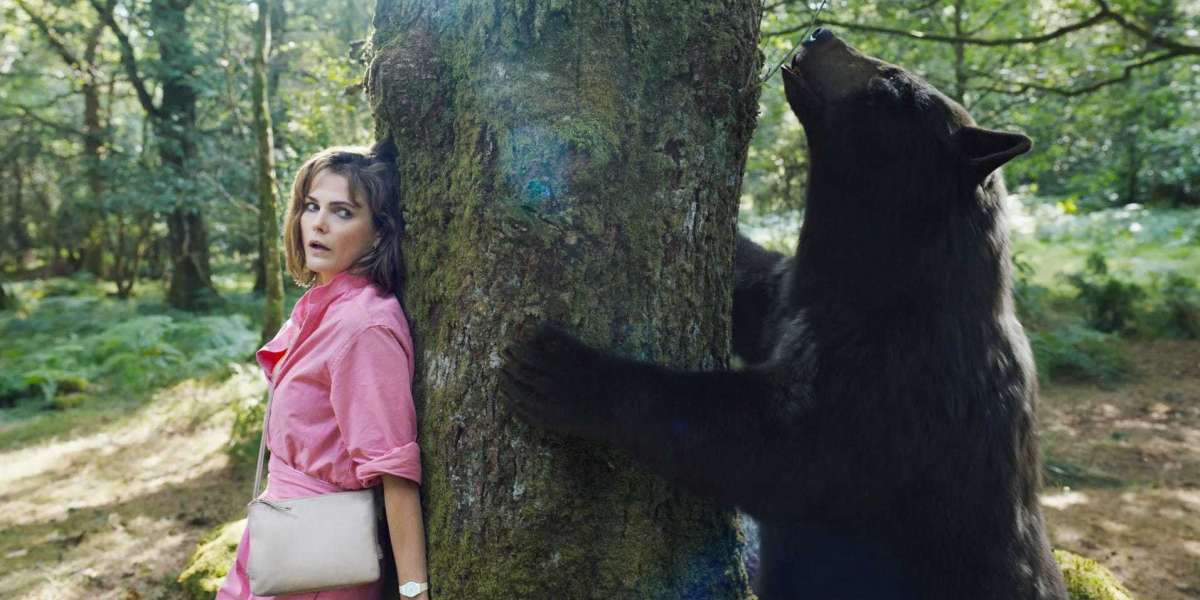Darkness falls. Out in the woods, under the pelting of a pitiless storm, a middle-aged American male, stripped to the waist, fights a furious bear. This elemental sequence comes from a 1977 film, scarily titled “Day of the Animals,” and the joy of it is that the battling man is played by Leslie Nielsen, and that the movie is not—repeat, not—intended as a comedy. What, you may ask, could top that?
One answer is “Cocaine Bear,” a new film written by Jimmy Warden and directed by Elizabeth Banks. Allegedly, it’s based on true events, in much the same way that “Pinocchio” is based on string theory. Our story begins with duffelbags of cocaine being tossed out of a plane over the Chattahoochee National Forest, in 1985. The bags belong to a drug dealer, Syd (Ray Liotta), and he wants them safely gathered in. To that end, his son, Eddie (Alden Ehrenreich), and a henchman, Daveed (O’Shea Jackson, Jr.), are dispatched to the great green wilds of Georgia. Also in attendance, and innocent of any crime, is a nurse named Sari (Keri Russell). She, too, is desperately seeking what is lost—her thirteen-year-old daughter, Deirdre, or Dee Dee (Brooklynn Prince), who has skipped school and gone hiking with her friend Henry (Christian Convery). Law enforcement is represented by a cop from out of state, Bob (Isiah Whitlock, Jr.), and a local ranger, Liz (Margo Martindale). The animal kingdom is represented by a butterfly, a deer, and a black bear. Only one of these is on cocaine, although with butterflies you can never really tell.
As with “So I Married an Axe Murderer” (1993) and “We Bought a Zoo” (2011), “Cocaine Bear” is explained by its title. If Banks is treating us to an allegory or a political parable, wagging her finger at our ecological sins, I must have missed it. From what I saw, she has simply made a film about a bear that does coke: eats it, snorts it, hunts it, sneezes it, and, at one rapturous moment, showers in it. (Is this a winking reference to “Little April Shower,” the daintiest scene in “Bambi”?) It’s as if Quentin Tarantino kicked off his career, in the early nineteen-nineties, with a tale of some dogs who visit an actual reservoir.
The trouble with high-concept films, though, is not the concept but the height. We laugh when we first hear about them, and we relish the buzz of the trailers; given that level of anticipation, it’s no surprise when the movies themselves take a tumble. Such was the case with “Snakes on a Plane” (2006), and it’s my forlorn duty to report that “Cocaine Bear” follows suit. Why does the whole cast, including the kids, swear so freely and so loudly (“We’re fucked,” Henry cries), if not to advertise the amazingness of the main plot? The violence, likewise, is far nastier than it needs to be, with cameos from severed limbs and an actress suffering the indignity of being dragged along a road, her face bumping and scraping in closeup. The excess, however gleeful, is that of a film paying anxious tribute to itself. Look, it seems to shout, here’s an apex predator becoming a homicidal junkie! What did you expect?
Now and then, the volume is turned down. The most believable interaction is not between man and beast but between mother and daughter—Sari and Dee Dee, early on, at home. Brooklynn Prince was terrific as an impish six-year-old in “The Florida Project” (2017), so why, as Dee Dee, is she allowed to drop out of the narrative for so long? Banks, always a sympathetic presence onscreen, doesn’t appear here, in her own film, but I can’t help wishing she did; the calm decency that she radiated in “Love Mercy” (2014) might have helped to settle this movie’s nerves. Instead, “Cocaine Bear” has a peculiar jostling quality, as the various characters shuffle onto center stage and then get elbowed aside to make way for the next contender.
We are left with an awkward question: for whom, exactly, are we supposed to root? For the bear, I guess, except that C.G.I., despite its wondrous re-creation of flesh and fur, is less adept at pixelating a personality, and there is little here to match the appeal of Baloo, in “The Jungle Book” (1967), who consumed nothing more potent than prickly pear and pawpaw. Cocaine, to be honest, feels like a very bare necessity. Still, there will be audiences who cackle like witches at this stuff, especially at midnight showings (if those jamborees still exist, in the age of streaming), and it may be that Banks will be lured back for sequels, with different stars and different mashups of addictive substances and untamed mammals. Get ready for “Fentanyl Hyena,” “Meth Bobcat,” and the uncompromising “Skunk Skunk.” The possibilities, I regret to say, are endless.
Were you to sit down and watch all five movies that are thrashing it out for Best International Feature Film at this year’s Academy Awards, what a curious binge it would be. You could start with “Argentina, 1985,” which, despite relying on the well-worn custom of the courtroom finale, has a refreshing lack of stridency. Next up would be “Close” and “EO”—the first being a saddening saga of two Belgian boys, and the second a form of pilgrimage. (The pilgrim in question is a donkey, and what he undergoes is not easy to bear, yet to follow in his hoofsteps is, I’d say, a transcendent privilege.) Taking a deep breath and a large whiskey, you could brave “All Quiet on the Western Front,” which, though only fitfully gripping, leaves you, in the harshest sense, entrenched. Finally, you could recover with “The Quiet Girl,” which, with Oscar night just around the bend, is the last of the contenders to be released.
VIDEO FROM THE NEW YORKER
The Originals: Neighborhood Nostalgia Comes to Life
Written and directed by Colm Bairéad, “The Quiet Girl” is set in Ireland in the early nineteen-eighties, though there are stretches of action, or sullen inaction, that could be unfolding ten or twenty years earlier. Also, the heroine, Cáit (Catherine Clinch), who is nine years old, with ghost-pale features and dark hair down to her waist, has a faintly abstracted air. It’s as if she were puzzled by her place in the modern world—shades of the dreamy kids in “Close.”
Cáit lives in a house of dismal gray, together with her parents, her brother, and her three sisters. (One oddity of the tale is how utterly devoid of sibling affection it is.) She speaks English to her father (Michael Patric), a grouch of unsavory habits (“I had a liquid supper”), and Irish to her mother (Kate Nic Chonaonaigh), who is pregnant with her sixth child and barely able to cope. The family needs to shed some excess baggage, and Cáit is the one to be tossed out—taken to spend the summer with distant relatives, on a farm.
How many stories have we seen, or read, that revolve around the exile of a child? “James and the Giant Peach” plunges its freshly orphaned hero into an aunt-infested nightmare; “The Secret Garden” passes through infirmity and resentment to reach a pastoral peace; and even “Heidi”—which we see Cáit reading, in “The Quiet Girl”—is more troubled than its reputation suggests. (So chronic is Heidi’s yearning for the mountains that she sleepwalks.) The home to which Cáit is sent, in contrast, seems like a genuine haven: a farmhouse owned by Seán (Andrew Bennett) and his wife, Eibhlín (Carrie Crowley), who takes one look at the new arrival, with her unwashed limbs, and runs her a hot bath. An unprecedented treat, one suspects, judging by the caution with which Cáit dips her toes in the water.
It’s a poised performance by Crowley, who lets us feel both the coolly guarded restraint in Eibhlín’s manner and the instinctive warmth with which she welcomes Cáit—wishing not only to care for her during the summer but also, by the illogic of love, to have done so sooner. “I don’t know why I didn’t think of taking you in before now,” she says. Is there a tinge of desperation in those words, kindly as they are? What else might Eibhlín have neglected to do? Finely framed by the cinematographer Kate McCullough, “The Quiet Girl” is an idyll, yet its placid surface is puckered by anxiety. Near the farm is a well, so clear and so still, like a magical source in a legend, that you can drink from it. Anyone who’s seen “Don’t Look Now” (1973), however, will think of children slipping into pools and ponds. Legends can be bitter to the taste.
Here and there, the movie overplays its hand. “If there are secrets in a house, there is shame in that house,” Eibhlín declares to Cáit, sounding like someone who recently escaped from an Ibsen production. Evidently, misfortune befell the place before Cáit came; among the clues, in the bedroom where she sleeps, are the clothes in the wardrobe and the wallpaper festooned with trains. The real surprise is that, in the course of the narrative, the elegant Eibhlín recedes into the shadows, as if everything were simply too much for her, while Seán, her gruff husband, is the one who draws their young visitor under his wing. As he points out, Cáit “says as much as she needs to say.” The camera constantly takes its cue from her darting gaze; the fact that she notices so much, and talks so little, is, for Seán, a virtue that he understands and shares. In the movie’s loveliest touch, he silently leaves a cookie for Cáit on the edge of a table. He could be putting food out for the birds.



